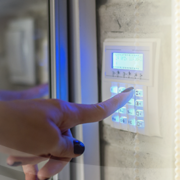Ancient Tombs and the Art of Access Control
Ancient civilizations sure knew how to send a guy out in style. The most famous surviving examples are the glorious tombs of Egyptian pharaohs and the Chinese terracotta army guarding the tomb of Emperor Qin Shi Huang. The ancient engineers expended great effort in the design of these tombs. They also knew quite a lot about access control.
For example, the architect of Amenhotep III’s tomb designed a nondescript room to represent the pharaoh’s final resting place. But, in reality, a false wall had been added in the back of the room. If tomb raiders broke though the wall, they then found a hall leading to the actual burial chamber.
They wouldn’t get far, though, because they would soon fall through a false floor, and down a 20-meter drop. What existed at the bottom of this chamber well is lost in time. Regardless, that fall could have easily proved fatal for the unfortunate intruder.
It is theorized that loyal locals would replace the false walls and floors each time someone “fell” for the trap. There would have been an element of monitoring in place to accompany the physical traps.
The designers of Emperor Qin Shi Huang’s tombs were allegedly equally guarded. Ancient texts refer to rivers of mercury surrounding Qin Shi Huang’s tomb, and scientific studies to this day show mercury levels exist near the tomb at over 100 times the normal amount.
While the terracotta soldiers were discovered in the 1970s, a majority of Qin Shi Huang’s tomb remains undiscovered because scientists fear mercury poison as well as booby-trapped, automatic crossbows that were coated in chrome to stand the test of time and repel any future thieves.
As far back as Amenhotep III and Qin Shi Huang (~3,400 years and 2,200 years ago, respectively) people knew that if you treasure something, you should instill safeguards so that only the right people can have access. It’s important to include this practice in your business.
Ancient Philosophy, Modern Execution
Securing your network is similar to how the ancient Egyptians and Chinese secured their tombs, but with fewer crossbows and poison rivers. Essentially, you want to couple physical deterrents with ongoing monitoring. Access control is a security measure that combines both.
Coded ID cards/key cards are one of the most common forms of access control. With this simple method, no one is able to access entry points to your building without proper security credentials, and there’s no need to change locks on doors when an employee leaves the company. You can simply update the access control database to update permissions as needed.
Think of access control as any method of providing a “key” that grants certain people access to certain resources. If your office administrator needs to get into the supplies room to retrieve a laptop for a new employee, she will have that authorization with the right key. Alternatively, there’s no reason that your temp should have the ability to enter a room to access laptops, monitors, and other supplies – so they don’t receive a key.
Access control will also monitor employee actions. So, if an employee enters the server room with the key, this information will be recorded and saved for posterity. Because access control provides a checks-and-balances system with employees, it discourages insider threats.
According to the Ponemon Institute, 62% of business users report having access to company data that they probably shouldn’t see. Additionally, 20 years of collecting incident data lead the Uptime Institute to determine that human error (i.e., bad operations) is responsible for approximately 70% of all data center incidents. The lesson the ancients understood well still stands: security starts with minimizing human error at every possible turn.
Access Control from TFE
You want your business operation to be an impenetrable tomb; a monument that also protects the awesome things you accomplish. There are people out there that fancy themselves Indiana Jones or Laura Croft, Tomb Raider looking for treasure. It’s our job at TFE to help you create the security systems, including access control, that keep your business and your network safe.
If you’d like more information on how access control can help protect your business, feel free to contact us.










